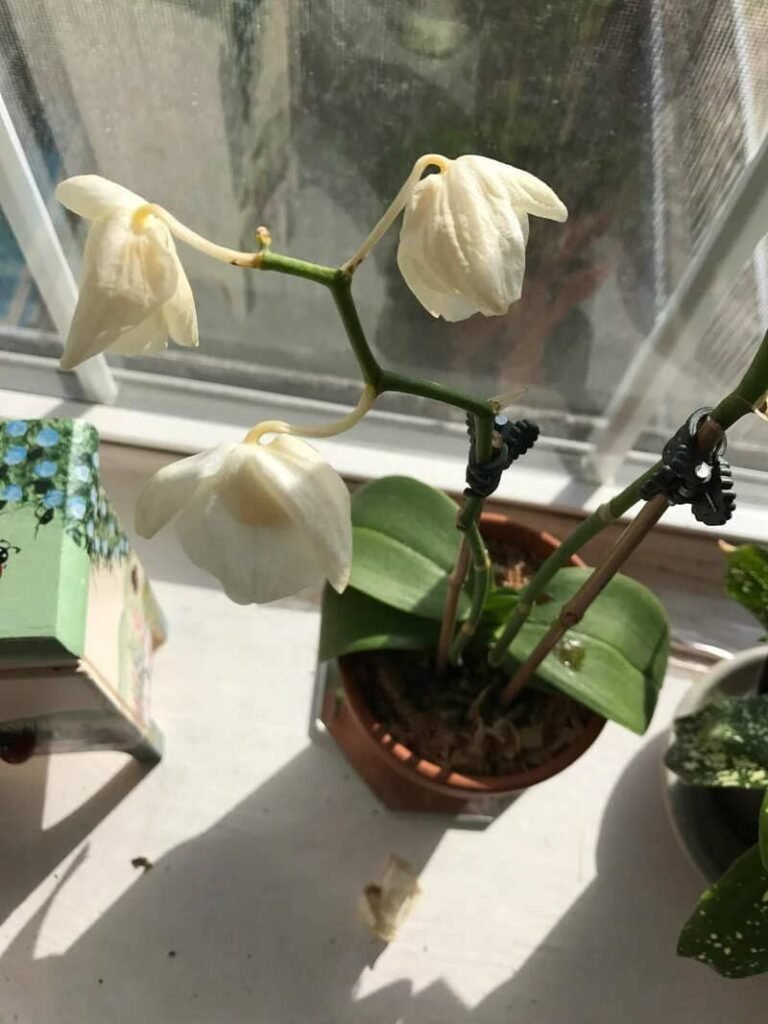Few things in life are as frustrating for a plant lover as the sight of their once-proud orchid flowers drooping. Orchids are the divas of the plant world: stunningly beautiful but oh-so-finicky.
If you’re staring at your wilting orchid and wondering what’s gone wrong, don’t worry—you’re not alone. Let’s unravel the mystery of drooping orchid flowers together.
First Things First: Why Do Orchid Flowers Droop?

When your orchid’s flowers begin to droop, it’s usually a cry for help. Orchids are highly sensitive to their environment, and even the smallest disruption can leave them unhappy. Here’s the kicker: a drooping flower isn’t necessarily a death sentence. Often, it’s the plant’s way of signaling that something’s off—and with a bit of detective work, you can bring it back to its glorious self.
To truly understand the situation, we need to dig deeper into the various reasons behind this issue. Orchids, after all, are complex yet fascinating plants that require a tailored approach to thrive. Let’s explore the primary causes of drooping flowers in depth.
1. Natural Flower Cycle: Is It Just Time to Let Go?
Before panicking, take a moment to consider if your orchid is simply at the end of its blooming phase. Orchids, like all living things, have their seasons. The average lifespan of an orchid flower ranges from a few weeks to a couple of months. If the blooms have been around for a while, they may just be wilting naturally as part of their life cycle.
Sometimes, it’s easy to overlook this natural process and mistake it for a problem. However, recognizing this stage is essential for setting realistic expectations about your orchid’s blooming habits.
What You Can Do:
- Don’t fight nature. Trim the flower spike once the blooms have fallen, but only after it has turned brown. This helps the plant conserve energy for its next bloom.
- Keep caring for the plant even after the blooms are gone. The leaves and roots still need attention to prepare for the next flowering phase.
2. Water Woes: Too Much or Too Little?
Orchids are particular about water. Too much, and the roots can suffocate, leading to drooping. Too little, and the plant can’t deliver nutrients to its flowers, causing them to wilt.
Signs of Overwatering:
- Mushy roots that are brown or black.
- Leaves turning yellow alongside drooping blooms.
Signs of Underwatering:
- Shriveled roots that feel papery or brittle.
- Wrinkled leaves that lack firmness.
Water management is a delicate balancing act with orchids. Their epiphytic nature means they’re accustomed to receiving water in short, infrequent bursts rather than being submerged for extended periods.
What You Can Do:
- Strike a balance! Water only when the top inch of the potting medium feels dry. Orchids prefer a soak-and-dry cycle, mimicking their natural tropical habitats.
- Use a pot with drainage holes to prevent water from pooling at the bottom, which can lead to root rot.
3. Humidity: The Secret Sauce for Orchid Happiness
Orchids hail from rainforests, where humidity levels hover between 50% and 70%. If your home’s air is too dry, your orchid may start sulking—and yes, drooping flowers are a sign.
Humidity plays a significant role in keeping orchid flowers perky and vibrant. Dry air can cause not just drooping but also premature flower drop.
What You Can Do:
- Place a humidity tray (a shallow dish filled with water and pebbles) beneath your orchid.
- Mist the plant lightly, but avoid misting the flowers directly—they can rot.
- Invest in a small humidifier if you live in an arid climate.
- Group your orchids together. Plants naturally release moisture into the air, creating a micro-humid environment.
4. Temperature Fluctuations: Orchids Love Consistency
Orchids hate surprises, especially when it comes to temperature. A sudden drop or spike in temperature can shock the plant, causing flowers to droop.
Ideal Conditions:
- Daytime: 65-75°F (18-24°C).
- Nighttime: 55-65°F (13-18°C).
Consistency is key. Even a slight deviation from these ranges can make an orchid unhappy, leading to stressed blooms and drooping petals.
What You Can Do:
- Keep your orchid away from drafty windows, heaters, and air conditioners.
- If moving your orchid outdoors for extra light, ensure the temperature doesn’t fluctuate drastically.
- Use a digital thermometer to monitor the conditions in the room where your orchid resides.
5. Nutrient Deficiency: Food for Thought
Orchids are light eaters, but they still need proper nutrition to thrive. If you’ve skipped feeding your orchid, or used the wrong fertilizer, the plant may struggle to keep its flowers healthy.
Nutrients like potassium and phosphorus are particularly important during the blooming phase. Without them, the flowers may lack the energy to remain upright and vibrant and thus may look droop.
What You Can Do:
- Use a balanced orchid fertilizer (20-20-20) diluted to half-strength every two weeks while the plant is actively growing.
- During the blooming phase, switch to a fertilizer that promotes blooms (like one higher in phosphorus).
- Avoid over-fertilizing, as this can damage the roots and lead to further issues.
6. Light Levels: Bright, but Not Blinding
Orchids crave light but prefer it indirect. Too much direct sunlight can scorch the flowers, causing them to droop prematurely.
Finding the right balance of light is an art form. Insufficient light can weaken the plant, while excessive exposure can damage its delicate flowers.
What You Can Do:
- Place your orchid near an east- or south-facing window with sheer curtains to filter the light.
- Avoid dark corners, as insufficient light can also weaken the plant.
- Rotate the pot occasionally to ensure even light exposure.
7. Stress Factors: Repotting and Relocation
Orchids are creatures of habit. If you’ve recently repotted or moved your plant to a new location, it might be stressed. This can lead to drooping blooms as the plant adjusts to its new surroundings.
Stress can also arise from changing the type of potting medium or exposing the orchid to unfamiliar conditions.
What You Can Do:
- Be patient. Orchids need time to acclimate.
- Ensure the new environment meets the plant’s light, temperature, and humidity requirements.
- After repotting, avoid fertilizing for a couple of weeks to let the roots recover.
Emotional Attachment: Don’t Take It Personally
It’s easy to feel defeated when your orchid flowers droop, especially if you’ve poured your heart into their care. But remember, plants are resilient. Orchids, in particular, have an incredible ability to bounce back with the right care. Treat every droop as a learning experience—a chance to better understand the language of your plant.
Every challenge with an orchid is an opportunity to grow as a gardener. These plants teach us patience, attention to detail, and the beauty of nurturing something delicate yet strong.
If there’s one takeaway from all this, it’s that consistent care is key. Orchids thrive when their needs are met regularly and predictably. Pay attention to your plant’s cues—the texture of its roots, the firmness of its leaves, and yes, even the drama of its drooping flowers.
Soon enough, your orchid will reward you with a spectacular display of blooms that make all the effort worthwhile. And trust me, when that happens, you’ll feel like a proud parent cheering on your star performer—because, in the world of orchids, every bloom is a standing ovation.
So, embrace the journey. Drooping flowers aren’t the end; they’re just a chapter in your orchid’s story. With love, care, and a bit of persistence, your orchid will continue to amaze you season after season.



